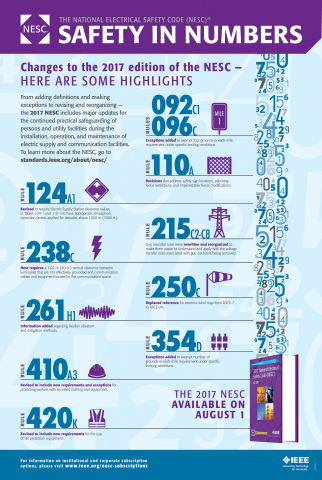PISCATAWAY, N.J.--(BUSINESS WIRE)--IEEE, the world's largest technical professional organization dedicated to advancing technology for humanity, and the IEEE Standards Association (IEEE-SA), today announced the release of the 2017 National Electrical Safety Code® (NESC®). The NESC is the authoritative code for ensuring the continued practical safeguarding of persons and utility facilities during the installation, operation and maintenance of electric supply and communication facilities.
Some impactful changes to the code include revised requirements for substation impenetrable fences, required consideration of Aeolian vibration for conductors, changes to accommodate new industry insulator ratings, as well as revisions to the rules in Part 4 that align with changes made to 29 CFR by the Occupational Safety and Health Administration (OSHA). Information on updates to the code can be found on the NESC homepage and subscribers can now view the code in the IEEE Xplore digital library.
The 2017 NESC also introduces new, helpful tools so that users can more easily access and utilize NESC content. One useful peripheral tool launching today is the 2017 NESC Handbook, Premier Edition. Along with commentary by contributors, this new handbook includes a representation of the code text making it the next-generation tool for professionals wanting to improve their understanding of the NESC. Later this fall, IEEE will also be offering a series of new educational online courses based on the NESC 2017 Edition, as well as introducing a mobile app for enhanced access to NESC content in the field.
“It’s been an honor serving as NESC chair and I’d like to thank all who participated in publishing the 2017 NESC with the most up-to-date electrical safety information,” said Mike Hyland, outgoing chair, NESC. “With new technologies emerging that will need to be addressed by the next edition the NESC has selected a highly qualified leadership team—one I’m confident will continue the work to augment the code and maintain its relevancy as an invaluable resource for safeguarding electrical supply.”
As Secretariat to the NESC, IEEE also announced the appointment of Nelson G. Bingel III, vice president product strategy, Osmose Utilities Services, Inc., as the new chair tasked with leading the ongoing advancement of the code during the next five-year revision cycle. Danna Liebhaber, principal electrical engineer, Bonneville Power Administration, the newly appointed incoming NESC vice chair, will work directly with Bingel as part of the new NESC leadership team.
“The NESC celebrated its 100-year anniversary in 2015. Today we are anticipating and addressing new technologies impacting electrical safety requirements in order to keep the code current and relevant. There is also a concerted effort to make the code more logical and useful for up-and-coming engineering graduates,” said Nelson Bingel, chair, NESC. “Increased exposure to the NESC will be driven by the new NESC mobile app, online learning courses and annual national events, encouraging a broader level of participation to improve the code—a movement I look to support through my leadership role over the next code cycle.”
An upcoming NESC Workshop is scheduled for 18-19 October 2016 in San Antonio, TX. A review of the changes in all sections of the code will be presented on the first morning. Additional segments will discuss renewable energy generation, microgrids, distributed energy resources, and interconnection as new technologies to be considered for future iterations of the code. Registration for the NESC Workshop is open now.
The 2017 NESC and handbook are available for purchase at the IEEE Standards store and available for subscription at the IEEE Xplore digital library.
To learn more about IEEE-SA, visit us on Facebook, follow us on Twitter, connect with us on LinkedIn or on the Standards Insight Blog.
About the IEEE Standards Association
The IEEE Standards Association, a globally recognized standards-setting body within IEEE, develops consensus standards through an open process that engages industry and brings together a broad stakeholder community. IEEE standards set specifications and best practices based on current scientific and technological knowledge. The IEEE-SA has a portfolio of over 1,100 active standards and more than 500 standards under development. For more information visit http://standards.ieee.org.
About IEEE
IEEE is the largest technical professional organization dedicated to advancing technology for the benefit of humanity. Through its highly cited publications, conferences, technology standards, and professional and educational activities, IEEE is the trusted voice in a wide variety of areas ranging from aerospace systems, computers, and telecommunications to biomedical engineering, electric power, and consumer electronics. Learn more at http://www.ieee.org.




